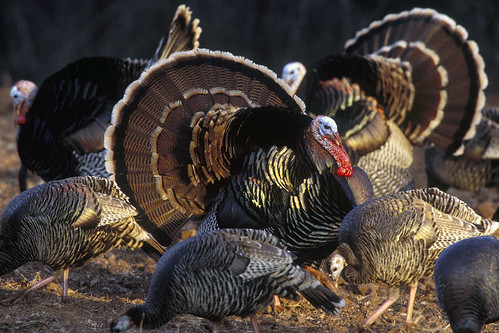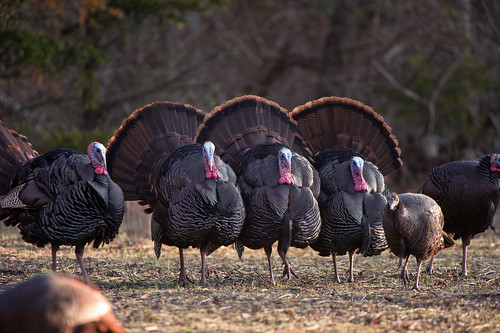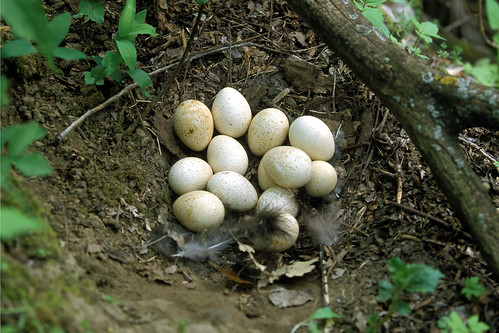
According to USDA’s Agricultural Marketing Service, the U.S. is the world’s largest turkey producer and largest exporter of turkey products. An estimated 46 million turkeys will show up on American tables this holiday, and most of those will come from turkey production facilities.
A much smaller percentage featured on the holiday table will be wild turkeys hunted on private and public lands. There are more than 7 million wild turkeys roaming the countryside, but their numbers were not always that robust. According to the National Wild Turkey Federation, which partners with the U.S. Forest Service, the tasty game bird native to the U.S. faced extinction in the 1930s.
The Forest Service works with the Wild Turkey Federation to improve the fowl’s habitat. The federation’s “Save the Habitat. Save the Hunt” campaign has a goal to enhance more than 4 million acres of upland wildlife habitat.
“It’s just not turkeys that benefit. It’s all species of wildlife,” said Steve Blatt, Forest Service biologist and liaison to the Turkey Federation. “Their members do a lot more than just help the turkey population. Projects in which we are working together may focus on turkey habitat, but there is a far broader reach to our work. We are conserving important habitat that helps a variety of wildlife, flora and fauna.”
The last few years the Forest Service and the Turkey Federation initiated substantial stewardship work, primarily associated with timber harvest, with money from the sale of the timber going toward wildlife habitat enhancement. The timber harvest work creates dense young forest conditions, which helps to provide sufficient cover and food and improves breeding habitat. Some of the service work maintains open grassy meadow areas that give wild turkeys their own buffet of food, including bugs and berries, and sufficient brood habitat for nesting.
“Some of the work we are doing, especially in the Eastern U.S., is maintenance of those open areas, which is where turkeys prefer to be for part of their life,” Blatt said. “We have a variety of ways we do that. Sometimes it’s mowing an area. Sometimes we conduct prescribed burns.”
Blatt said improving wild turkey habitat includes other projects, such as ridding the area of invasive species.
“If we let a nonnative invasive species take hold, like the tree of heaven, it would dominate the forest and would have dramatic effects that would bring changes to habitat conditions, which in turn can hurt wildlife populations now and into the future,” Blatt said. “Together we restore habitat because it’s good for everyone -- for the hunters, for the wildlife, for the ecosystem.”
Restoring habits means giving wild turkeys what they need. In the wild, turkeys eat things like bugs, acorns, and soft mass edibles like berries and grapes. In some areas of the country, we’re improving riparian habitat conditions by providing protections to springs, streams, rivers and other water bodies. Forest Service work and partner support from organizations like the National Wild Turkey Federation help ensure that turkey population numbers do not revert back to echo the 1930s.
There are only two species of turkeys that fall under the scientific genus Meleagris: Meleagris gallopavo, or the North American wild turkey that includes five distinct subspecies, and Meleagris ocellata, the oscillated turkey that exists only in a 50,000-square-mile area that includes parts of Mexico, Belize, and Guatemala.

Today in the U.S., there are roughly 5 million Eastern wild turkeys in 38 states and four Canadian provinces and are often the largest of all turkey sub-species, growing up to 4 feet tall and weighing more than 20 pounds. The Rio Grande species of wild turkey is the second-largest population with more than 1,000 found in North America. Rio Grande wild turkeys are native to the Plains states and grow to 4 feet tall but with longer legs than the Eastern wild turkey.
Smaller populations of wild turkeys include the Osceola that number between 80,000-100,000 and are found primarily on the peninsula of Florida; the 334,000 Merriam’s wild turkeys prefer the ponderosa pine, western mountain regions of the U.S. and have distinctive white feathers on the lower back and tail feathers; and the relative handful – roughly 700 or so – of Gould’s wild turkeys are the least known of the species. They can be found in southern portions of Arizona and New Mexico and in northern Mexico.
So, which species of turkey is the best?
“Ha. That’s easy: The one you’re having for Thanksgiving dinner,” Blatt said.
So on Thursday if the conversation lags try a little turkey trivia. Did you know the red-pink fleshy growth on the head and upper neck of a turkey is called the caruncle? Don’t confuse that with the snood, the long, red, fleshy growth from the base of the beak that hangs down over the beak. The incubation period required for a turkey egg to hatch is 28 days, and the hen could lay up to 12 eggs – at the rate of about about one egg a day. When an egg hatches, you get a poult, or baby turkey. As they grow, a turkey will have between 5,000 and 6,000 feathers grown in feather tract patterns. And those feathers are pretty useful. They keep a turkey warm, help them to fly up to 55 mph and help attract the opposite sex during mating season.
Editor’s note: National Wild Turkey Federation contributed information for this blog.

